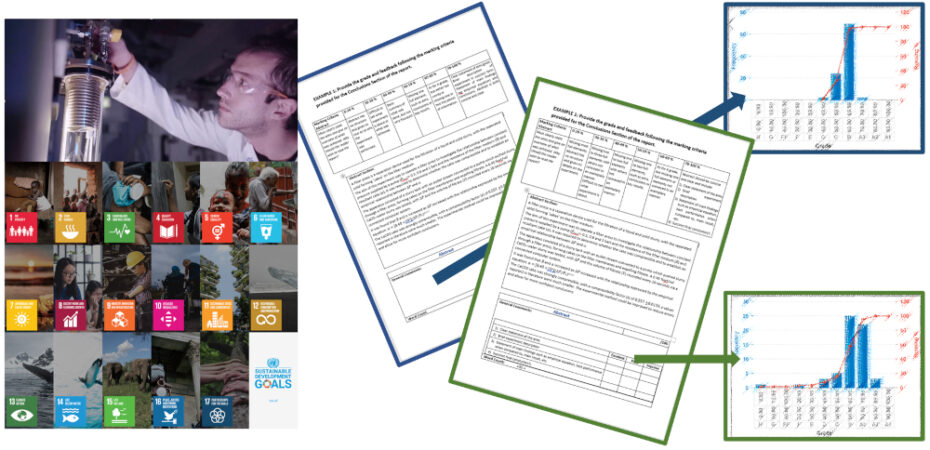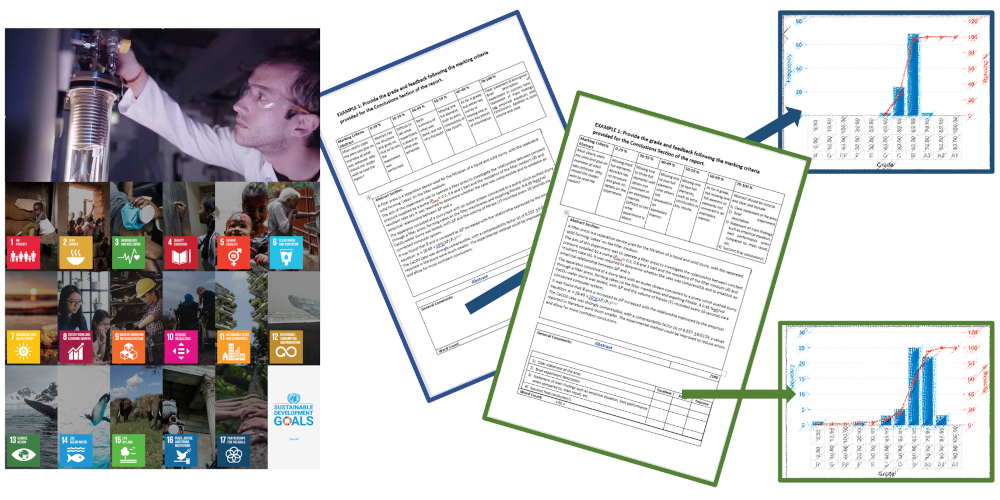
In this post, Daniel Orejon details how the Chemical Engineering Laboratory 3 (CEL3) labs team redesigned the marking and feedback process for coursework assignments, such as written reports, which can be affected by marking inconsistencies and subjectivities. Daniel is a Senior Lecturer in Chemical Engineering and presented this work as a demonstration workshop at the Learning and Teaching Conference 2025. This post is part of the ‘Transformative Assessment and Feedback’ Learning and Teaching Conference series.
In addition to providing a means to assess the student’s learning level, assessment and feedback processes support our students learning and learning experience throughout their academic journey. Hence, getting it right is of great importance. This is even more important in the case of coursework in the form of a report without specific and/or exact numerical answers where marking becomes more subjective and less objective. This can lead to inconsistencies among different markers and/or topics where often the marks and feedback of written reports are reliant on the subjectivity and dedicated work of the marker.
Aiming to minimise markers subjectivity and to provide more uniformity on the feedback throughout, i.e., provide fairer grades and more consistent feedback to the students, as well as to minimise the academic/demonstrator marking time/working load, we:
- Provide more specificity and granularity within the different marking scheme descriptors;
- Minimise the available number of rubrics levels for: Excellent, Acceptable and Improve; and
- Unify the feedback sheet and marking scheme.
The Course Assignments
Chemical Engineering Laboratory 3 (CEL3) year-long laboratory course is assessed via 100% coursework submission. Students conduct five different, in-person experiments in the themes of Heat Transfer, Heat and Mass Transfer, Packed Beds or Fluidised Beds, Reaction and Separation processes. Each of the laboratory sessions is assessed via a different type of assignment, varying from written reports to presentations (summarised in Figure 1).
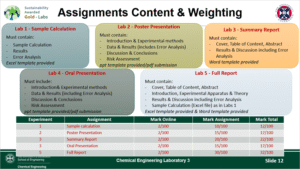
Evolution of the Marking Scheme and Feedback Sheet
1. Marking Scheme
Typically, marking schemes related to coursework are divided into different descriptors, either evaluating the different sections of the report or learning outcomes of the course. In CEL3, the marking scheme descriptors correspond to the different sections of the report as: Presentation, Abstract, Introduction, Theory and Apparatus, Results, Discussion, Conclusions, and Sample Calculations. Individual grades and feedback are provided for each of the descriptors, which allows students to clearly relate the mark and feedback for each specific section of their report.
Next, I highlight the main differences between CEL3 AY19/20 and CEL3 AY24/25 marking schemes. A clear difference between these marking schemes is the content of what it is expected for an A-grade where CEL3 AY19/20 provided a general description (Figure 2 – left); whereas CEL3 AY24/25 is more granular and itemised (Figure 2 – right). The rest of grades are based on the expectations for an A-grade.
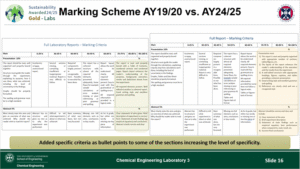
2. The Feedback Sheet
We also realised that having a large number of rubric levels for grading between 0 and 100 decreased the grades variability, most of them self-containing between 55 (for good or pass) and 70 (for excellent). To avoid such a pitfall, we opted to simplify the number of rubric levels from 100 to a total of 3 levels: Excellent (100), Acceptable (60) and Improve (30).
Furthermore, to provide more consistency as well as greater amount of feedback as well as to minimise the academic/demonstrator marking time/working load, we unified the marking scheme within the feedback sheet. The feedback sheet now includes the specific list of items contained within each of the marking scheme descriptors. See Figure 3 for a comparison between marking sheet of CEL3 AY19/20 versus CEL3 AY24/25.
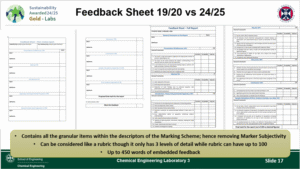
Demonstration workshop at the Learning and Teaching Conference 2025
I delivered a Demonstration Workshop at the annual University of Edinburgh Learning and Teaching Conference 2025, to demonstrate the effectiveness of the above changes to the marking scheme and feedback sheet.
The participants in the workshop were provided with the Full Report Abstract submitted by our students in AY22/23 (shown with permission), which had been marked by the corresponding academic in AY22/23 (for later comparison). Two Abstract examples – Example 1 and Example 2 – were then evaluated making use of the former (AY19/20) and the current (AY24/25) CEL3 Marking Scheme and Marking Sheet. Each participant evaluated either Example 1 or Example 2. Figure 4 includes the sheets provided to the participants as Example 1 and Example 2 embedded with the (left) former (AY19/20) and the (right) current (AY24/25) CEL3 Marking Scheme and Marking Sheet.
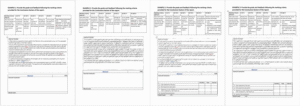
Workshop participants were given five minutes (in line with the time given to academics) to read the Marking Scheme and the Abstract and to provide the grade and written feedback anonymously; first making use of the former procedure and then the current procedure. Upon completion, the grades provided for each example were averaged and standard deviations calculated for both Example 1 and Example 2. In addition, the number of words were also counted. Figure 5 and Table 1 includes the quantification of the data along with the actual grade and words number from the CEL3 academic for comparison.

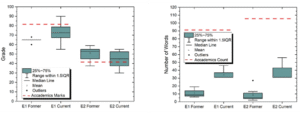
Conclusion
The effectiveness of the proposed rubric grades simplification and marking scheme-feedback unification for best practice in (Chemical) Engineering Laboratories is hence demonstrated. On one hand, we confirm the expected increase in grades variance by the current CEL3 AY24/25 Marking Scheme and Feedback Sheet, which accounts for a more realistic outcome of the expected students’ marks, with their consequent increased satisfaction. On the other hand, the more substantial in terms of number of words and specific in terms of granularity/itemised of the feedback provided is also evident. Moreover, the increase in the grades variance within the course is also confirmed by the wider bell shaped of the CEL3 grades across academic years as demonstrated in Figure 6. Findings reported could benefit other courses with coursework assessment and feedback as well as other disciplines with laboratory coursework components.
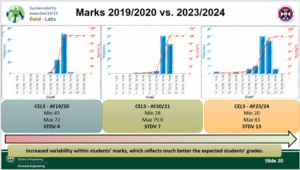
Acknowledgments
A biggest thanks go to the different CEL3 students’ cohorts over the years. In addition, a big thanks goes to all the members of the Chemical Engineering CEL3 labs Team including Academics: Nacho and Glen, T&Ds: many of you and you all know who you are, and Technical Staff: Gordon and Isis.
Other useful online resources
- A blog post on Adaptation of the Chemical Engineering Laboratory 3 to online and hybrid teaching. also presented at the Practical Engineering Education 21 PEE21 at the University of Sheffield in 2021 as: Hybrid Practical Work: by in-Campus Students for off-Campus Students.
- A blog post on the methodology and findings of the proposed online preparation as: Interactive Learning Environment On-Line Preparation for Enhanced Confidence and Learning in Chemical Engineering Experimental Laboratories. Also presented at the University of Edinburgh Learning and Teaching Conference 2023: Interactive Learning Environment On-Line Preparation for Enhanced Confidence and Learning in Chemical Engineering Experimental Laboratories, and at the Practical Engineering Education 24 PEE24 at the University of Sheffield in 2024 as: Enhanced Confidence and Learning in Practical Chemical Engineering via Online Preparation.
 Daniel Orejon
Daniel Orejon
Daniel Orejon (Dani) is a Senior Lecturer in Chemical Engineering at the Institute for Multiscale Thermofluids (IMT) at the University of Edinburgh in UK and Associate Visiting Professor at Kyushu University Japan since 2019. Dani completed his PhD on the fundamentals of evaporation phase-change at the droplet scale, both during free evaporation and under external forces applied in 2013. Dani is the Deputy Head of the Engineering Graduate School at the School of Engineering, Teaching Laboratory Manager for the Chemical Engineering Discipline, and is a Fellow of the Higher Education Academy since April 2021.

